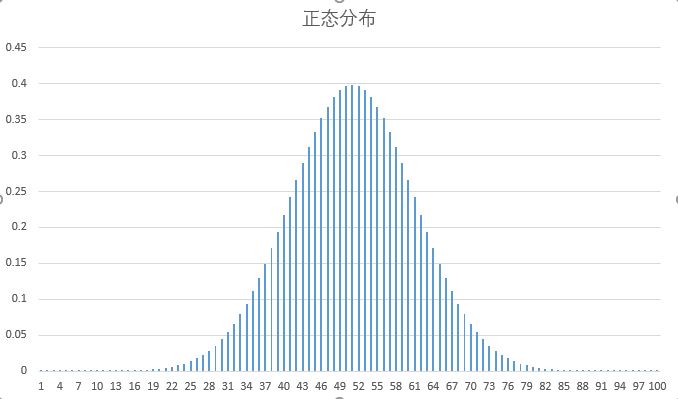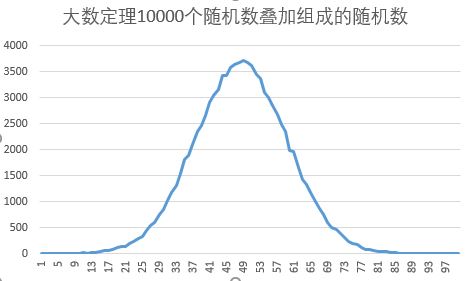1.概率均匀分布(C语言)
#include <stdio.h>
#include <stdlib.h>
#include <time.h>
int main( int argc, char **argv)
{
int i=0, v, mod, n;
/* srand函数是随机数发生器的初始化函数 */
srand((unsigned) time(NULL));//此行可以删除
mod = 10;//range of random
n = 100000;//number of random
int *count = malloc(sizeof(int)*mod);
i=0;
do{
count[i++] = 0;
}while(i<mod);
i=0;
do{
i++;
v = rand() % mod;
printf("%2d ", v);
if(i%10 == 0)
printf("\n");
count[v] ++;
}while(i<n);
i=0;
do{
printf("count[%d] = %d\n",i, count[i]);
i++;
}while(i<mod);
return 0;
}
结果:
count[0] = 9973 count[1] = 10146 count[2] = 9909 count[3] = 9837 count[4] = 10079 count[5] = 10111 count[6] = 9999 count[7] = 10002 count[8] = 9977 count[9] = 9967
2.正太分布公式(C语言)
#include <stdio.h>
#include <stdlib.h>
#include <time.h>
#include <math.h>
#ifndef pi
#define pi 3.141592653
#endif
int main( int argc, char **argv)
{
int mu = 5, cigma = 1;
int n, ix;
float dn, x;
n = 100;
dn = 0.1;
float *N = malloc(sizeof(float)*n);
for(ix=0, x=0; ix<n; ix++, x+=dn)
{
printf("%d, %f\n",ix, x);
N[ix] = sqrt(1.0/(2*pi*cigma*cigma))*exp( -1.0/(2.0*cigma*cigma)*(x - mu)*(x - mu) );
}
FILE *fp = fopen("normal.txt","w");
for(ix = 0; ix < n; ix ++)
fprintf(fp,"%f\n",N[ix]);
fclose(fp);
return 0;
}
结果成图:
3.中心极限定理(大数定理)
该定理的定义为很多随机变量的和近似服从正太分布,给出代码并改变参数作图:
#include <stdio.h>
#include <stdlib.h>
#include <time.h>
#include <math.h>
#ifndef pi
#define pi 3.141592653
#endif
float Normal_0(float mu, float cigma, float x)
/* normal distribution with fmulation */
{
return sqrt(1.0/(2*pi*cigma*cigma))
*exp( -1.0/(2.0*cigma*cigma)*(x - mu)*(x - mu) );
}
#define NSUM 250
int Normal_1()
/*Theorem of large numbers
or Central Limit Theorem
*/
{
srand((unsigned) time(NULL));
float x = 0;
int i;
for(i = 0; i < NSUM; i++)
{
x += rand() %10;
//printf("%f\n",x);
}printf("%f\n",x);
return (int)(x/NSUM);
}
int main( int argc, char **argv)
{
srand((unsigned) time(NULL));
int i, j;
int n = 10000, RAN_MAX = 1000, SUM, mod = 100;
int *count = malloc(4*mod);
for(i=0;i<mod;i++)
count[i] = 0;
FILE *fp = fopen("tmp.txt","wb");
int min = 9999999, max = -9999999;
for(i=0;i<n;i++)
{
SUM = 0;
for(j=0;j<RAN_MAX;j++)
{
SUM += rand() % mod;
}
fprintf(fp,"%d\n",SUM);
}
fclose(fp);
fp = fopen("tmp.txt","r");
for(i=0;i<n;i++)
{
fscanf(fp,"%d\n",&SUM);
if(SUM < min)
min = SUM;
if(SUM > max)
max = SUM;
}
printf("min = %d, max = %d\n",min,max);
rewind(fp);
for(i=0;i<n;i++)
{
fscanf(fp,"%d\n",&SUM);
SUM = (int)((float)(SUM-min)/(max-min)*mod);
count[SUM] ++;
}
for(i=0;i<mod;i++)
{
printf("%d\n",count[i]);
}
return 0;
}
中间会生成临时文件“tmp.txt”,里面保存了随机变量的和,我们对这些参数进行“归一化”,并作图得出下图:


